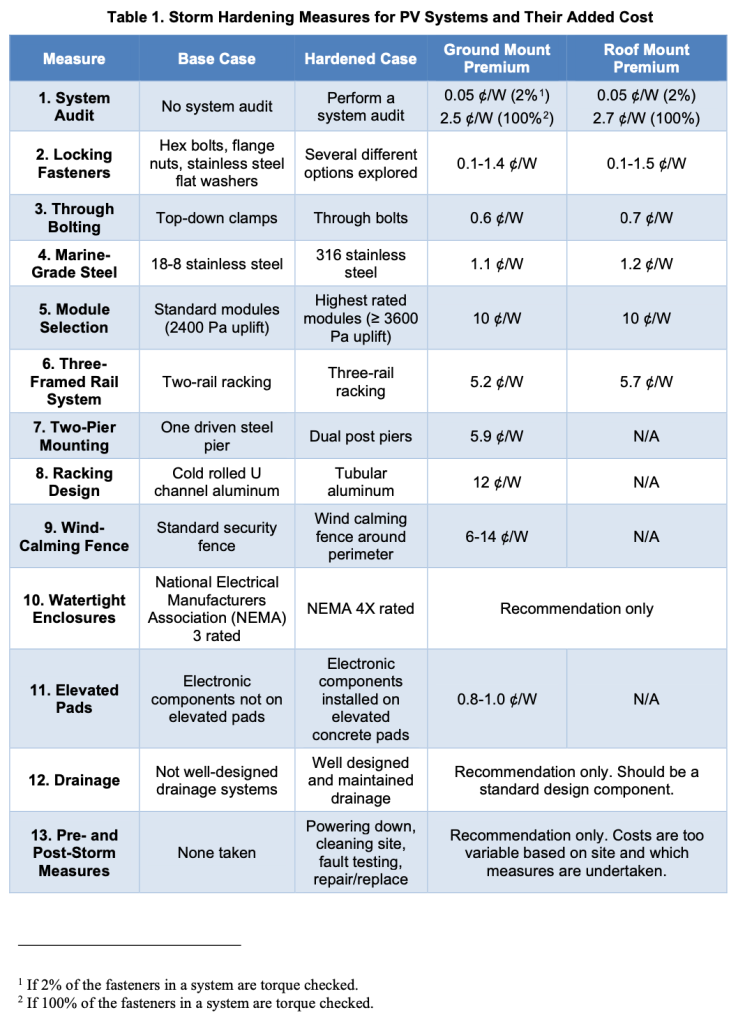Resilience can be defined as the ability to anticipate, prepare for, and adapt to changing conditions and withstand, respond to, and recover rapidly from disruptions through adaptable and holistic planning and technical solutions (Hotchkiss 2016). Solar photovoltaic (PV) power has many advantages as a resilient power source, including the ability to provide power after a natural disaster. While solar arrays can survive severe weather events, in some case systems are compromised and left unable to provide power (Hotchkiss 2016). For PV systems to act as resilient power providers, they must remain operational. Building a system that is more likely to survive a severe storm event can come at a higher construction cost than those built to less stringent standards.
Previous efforts have identified various system measures and practices that can increase the likelihood of a PV system surviving a severe weather event (Robinson 2018; Burgess 2018; FEMA 2018). This report provides initial estimates for the up-front cost premiums for various methods of storm hardening PV systems.
This report aims to:
- Provide an initial estimate of the additional costs of various storm hardening measures for PV systems
- Disseminate information and about strengthening PV systems and to foster greater industry communication and momentum around the topic
- Promote a greater consideration for potential lifetime PV system maintenance costs
- Encourage a greater consideration of the site environmental conditions and extremeweather events a PV system is likely to encounter over its operational lifetime
- Help developers weigh the costs of storm hardening a PV system compared to the costsof recovering, repairing, and repowering a compromised system following an extremeweather event
- Provide a resource for developers installing systems in severe weather locations, siteoperators, investors, codes and standards developers, among others.
- Promote the installation of more resilient PV systems
- Form the foundations of future work to more accurately estimate the costs of installingresilient PV systems.Overall, the main steps to PV resilience are quality assurance in system design, quality control during installation, and ongoing operations and maintenance (O&M) (Lopata 2019). Systems can fail because of one, two, or all steps, or for another reason altogether—a storm of extreme force, for example. To achieve more resilient PV systems, it is paramount that PV developers and installers promote rigorous attention to quality throughout the project. This report focuses largely on specific design features that can help make PV system’s more resilient, but ensuring quality construction and installation is equally important.This report investigates 13 storm hardening measures for solar PV systems, summarized in Table 1. For more background on these measures, please reference Robinson (2018).
This document summarizes early efforts to estimate the initial costs of storm hardening measures for PV systems. It is informed by feedback that the National Renewable Energy Laboratory (NREL) received from industry experts through one-on-one interviews. This work is only as reliable as the feedback received, and NREL understands that some of the cost estimates may differ from actual costs from projects around the globe. Furthermore, system costs are constantly changing, so the values in this report represent an average snapshot of the state of the industry. We also do not account for local variation in costs. The authors welcome feedback to achieve an even more accurate representation of storm hardening costs.
This report analyzes ground-mounted and roof-mounted fixed tilt solar PV systems only. It does not include tracker systems because fixed tilt systems are typically sturdier and an installation constructed to be storm hardened should be designed to be more structurally stable. However, tracker systems currently account for the majority of large-scale PV being installed, and they are being installed in storm-prone regions. Future work will aim to investigate storm-hardening for PV tracking systems.
This report only analyzes initial costs of each of the considered measures. While it will naturally cost more to design and build a more robust system, this initial cost could lead to outyear cost savings. These lifecycle cost savings could come from reduced O&M, decreased repair costs, and shorter system downtimes, among others. While difficult to quantify, there is also a value in resilience and increasing the likelihood of a PV system providing power after a severe weather event.
An intended outcome of this report is to identify the long-term benefits of installing storm hardened PV systems. While the focus is on severe weather regions, many of the design principles could increase resilience in other regions, as well. This report may spur further research into this area, the development of products and solutions specifically tailored to severe weather sites, and to greater understanding of the value of resilient PV installations, all of which could lead to more resilient PV systems worldwide.
This report is available at no cost from the National Renewable Energy Laboratory at http://www.nrel.gov/publications.
Download the Report






Very Insightful. Thanks for sharing.
Keep up the good work
LikeLike